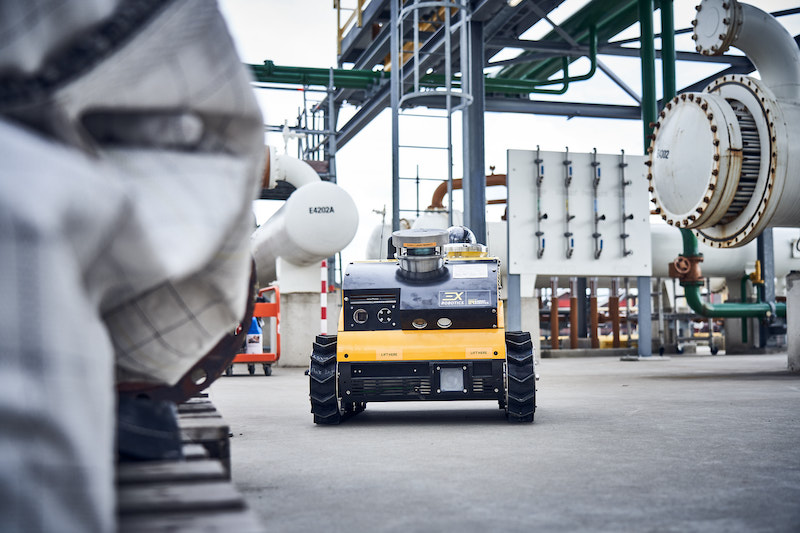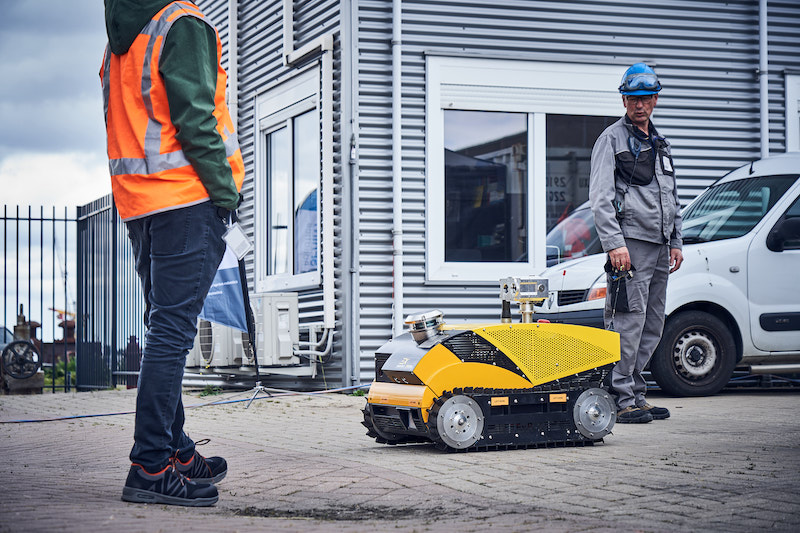
ExRobotics develops ‘new and improved’ version of its inspection robot
ExRobotics has developed a “new and improved” version of its ATEX-certified inspection robot, together with the help of Shell Pernis and DOW Terneuzen.
ExRobotics says “many companies” have adopted this way of working, and as a result, there are now 30 of its robots operating worldwide on a daily basis.
Why do industrial companies send employees into potentially hazardous environments (ATEX Zone 1 environments) when robots could do some of the work? Several studies have shown that inspection of hazardous environments by robots is the solution to preventing human injury during inspection. Robots perform inspections more accurately, more productively and more cost-effectively than humans.
With this thought in mind, ExRobotics, started developing the ATEX Zone 1 certified robot several years ago. The EXR-1 hit the market in 2019, a world-first, and ExRobotics began working with Shell and Dow to learn how to deploy this new technology in daily operations.
Although the first version of the robot met explosion safety requirements, industrial companies were still limited in their ability to use it for inspections. In practice, the robot fell short in a number of areas, including visual inspection capabilities, payload capability, localization and navigation, and vibration and heat detection.

Implementation
Petrochemical companies are implementing a three-step process using ExRobotics’ autonomous inspection robots. In the first step, the robot collects all required data autonomously by following a pre-defined route and inspection points that can be set through a web interface.
In the second step, various algorithms convert the data into information which is summarized in a mission report. Any discrepancies are flagged and sent to the control room in the third step, or can be sent via an API to other customer systems. The robots can also receive commands and be sent out to collect data through this interface.
In the period between the start of 2020 and April 2022, intensive work between ExRobotics, Shell and Dow has been done to help learn how the inspection normally performed by operators can be performed by robots.
The vision that has been developed in parallel within Shell is that operators only come into a plant when they need to use their hands. Thus, all non-manipulation tasks will be taken over by robots and other technologies. From this arises the title, Operators Rounds by Exception.
In the early days, pilots were conducted with the ExR-1 robot, but it soon became apparent that its deployment was too limited. With this experience, the ExR-2 robot was developed. The biggest innovation is that the new robot can operate completely autonomously. No remote control is needed anymore, as was the case with the first variant.
The solution currently used by many petrochemical companies can be summarized in three steps.
- In step 1, the robot autonomously collects all desired data. The route and inspection points can be defined by the customers themselves via a web interface. After this “teaching round”, the robot will neatly repeat the inspection each time. After the inspection round, all that data is published in the cloud, where step 2 starts.
- In step 2, data is converted into information by various algorithms (Artificial Intelligence). Based on a labor study conducted by Shell, we now know that it takes 47 algorithms to simulate an operator inspection round.
- Step 3 is when the information is summarized in a mission report and if there are any discrepancies, a notification is sent to the control room.
Another possibility is to send all “raw” data including interpretation via an API to other customer systems. An example herein is a link with the DCS of the factory.
For this purpose, ExRobotics has developed a standard API with Yokogawa in Japan (supplier of DCS systems). Through this interface, data can be linked to other data sources, but also the robot can receive commands and be sent out to collect data.
Next steps
ExRobotics is in the mean time working on the next step: the combination of a digital twin, inspection data and artificial intelligence. The robot is now generating its own digital twin for localization and navigation (point cloud twin).
In the next development, this twin will be “fused” with customers’ 3D models (asset twin) and all collected data will be “stitched” onto the digital world in a time series. Because the robot can perceive more than humans (infrared, ultrasonic, vibration, etc) and this data is “remembered” for a long time, many new applications arise.
Customers can include other data in the 3D models, such as factory data, IoT data and data from drone inspections. The combination of artificial intelligence and a digital twin gives new possibilities and goes one step further.
When the digital twin identifies an anomaly, but at the same time needs more data to be sure, it automatically sends the robot on its way. “The digital twin combined with artificial intelligence can thus become the manager of the fleet of robots, drones and other autonomously operating devices.”
Emission detection
Volatile gases can be harmful to humans and the environment. They are released during evaporation from incomplete combustion of petroleum products and other organic substances.
Prolonged contact with these volatile emissions can cause respiratory irritation, eye irritation, headaches, nausea, heart problems and even nervous system damage.
ExRobotics’ emission detection robot allows factories to detect these types of leaks. It is an essential tool in the fight to reduce fugitive emissions of methane, benzene and other harmful gases.
The Emissions Detector works without human intervention. The robot can detect different levels of gases. It performs daily autonomous checks in which the robot follows pre-planned routes.
If the robot detects harmful gases, it sends an automatic notification with the location of the leak in question to the plant control room manned by an operator. The operator can safely take action and reduce or contain the fugitive gases.
ExRobotics’ robots can be equipped with different features and functions so the robot can be used for different purposes.
This has led to the four robots:
- Emissions Detector;
- First Responder;
- Co-Operator; and
- Inspector.
The robots are the new benchmark for inspecting and investigating a potentially explosive factor in the plant.
The result
With the help of Shell and DOW, as well as other customers, the ExR-2 robot is in use at several Shell companies around the world (the Netherlands, Singapore, Canada and Germany), but also at other companies such as Equinor (Norway), BP (UK), Chevron (US), O&G OPCOs in the Middle East, Yokogawa (Japan), Repsol (Spain), BASF (Germany), Woodside (Australia) and Wood (US).
What is striking is that in addition to getting people out of a dangerous situation, each round can also be checked for methane emissions (small spills). About 25 percent of methane emissions come from the oil and gas industry.
Worldwide, 70 million tons of gas leak out each year and methane has 30 times more effect on global heating than CO2. The good news is that this problem is solved today, in seven years the effects of this, can me measured.
Methane breaks down much faster under sunlight than CO2. So the European Commission argues that policy methane emissions could play a “very important role” in enabling the EU to meet its 2030 climate ambitions.
Sustainable development goals
ExRobotics says it is committed to health, safety and the environment and also contributes to multiple United Nations Sustainable Development Goals. Striving to enhance proper health and well-being (SDG 3) by getting people out of dangerous situations.
ExRobotics adds that it contributes to “decent work and economic growth” (SDG 8) by creating high-tech jobs. Finally, ExRobotics contributes to climate action (SDG 13) by detecting fugitive emissions with the emission detection robot.
Thus, goals such as methane reduction, safety and cost savings can still go hand in hand. This solution allows robots to measure and detect different levels of gases. With the built-in gas sensor, the robot maps the relevant area. This invention gives customers access to maps of emission exposures and demonstrates early detection of leaks.
